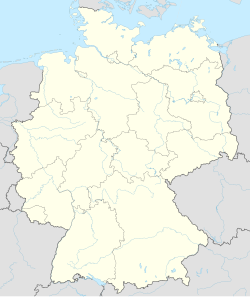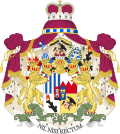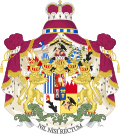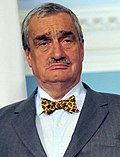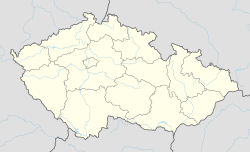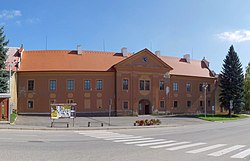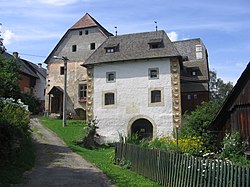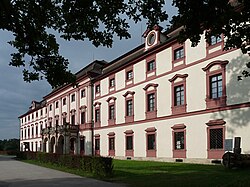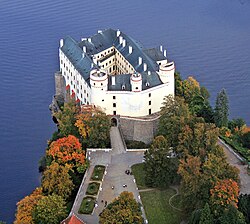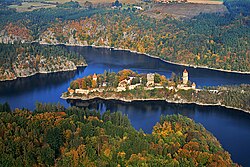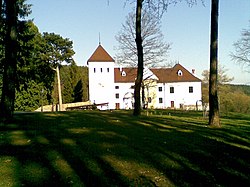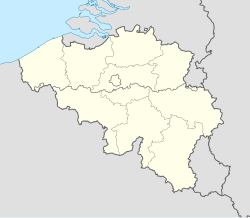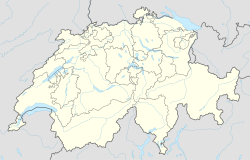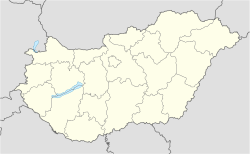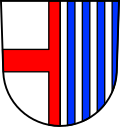Top Qs
Timeline
Chat
Perspective
House of Schwarzenberg
German and Czech noble family From Wikipedia, the free encyclopedia
Remove ads
The House of Schwarzenberg (German pronunciation: [ˈʃvaʁtsn̩ˌbɛʁk] ⓘ) is a German (Franconian) and Czech (Bohemian) aristocratic family, formerly one of the most prominent European noble houses. The Schwarzenbergs are members of the German and Czech nobility, and they once held the rank of Princes of the Holy Roman Empire. The family belongs to the high nobility and traces its roots to the Lords of Seinsheim during the Middle Ages.[1] The secundogeniture branch of the Schwarzenbergs was among the foremost Czech patriotic houses.
The current head of the family is Prince Johannes (born 1967), son and heir of the late Karel, 12th Prince of Schwarzenberg (1937–2023), a Czech politician who served as Minister of Foreign Affairs of the Czech Republic. The family owns properties and lands across Austria, the Czech Republic, Germany, and Switzerland.
Remove ads
History
Summarize
Perspective
Origin
The family stems from the Lords of Seinsheim, who had established themselves in Franconia during the Middle Ages.[1] A branch of the Seinsheim family (the non-Schwarzenberg portion died out in 1958) was created when Erkinger of Seinsheim acquired the Franconian territory of Schwarzenberg and the castle of Schwarzenberg in Scheinfeld during the early part of the 15th century. He was then granted the title of Freiherr (Baron) of Schwarzenberg in 1429. At that time, the family also possessed some fiefdoms in Bohemia.
Ascent and expansion
In 1599, the Schwarzenbergs were elevated to Imperial Counts, and the family was later raised to princely status in 1670.[1] In 1623 came the Styrian Dominion of Murau into the Schwarzenberg family due to the marriage of Count Georg Ludwig of Schwarzenberg (1586–1646) with Anna Neumann von Wasserleonburg (1535–1623). Furthermore, the House of Schwarzenberg acquired extensive land holdings in Bohemia in 1661 through a marriage alliance with the House of Eggenberg. In the 1670s, the Schwarzenbergs established their primary seat in Bohemia and, until 1918, their main residence was in Český Krumlov, Bohemia (now in Czech Republic).
Schwarzenberg/Sulz family unification
Due to the absence of a male heir and his only daughter Maria Anna married to Prince Ferdinand of Schwarzenberg, Johann Ludwig II Count of Sulz proposed a family unification between the Counts of Sulz and Princes of Schwarzenberg at the Imperial Court. His request was granted, which not only transferred all legal and property rights upon his death in 1687 from the Sulz family to the Schwarzenberg family, but assured that the Sulz family continues in the Schwarzenberg family. The visible affirmation of this bond was the merging of the coat of arms.
- Alliance crest on Jinonice castle
- Ferdinand & Maria Anna
- Alliance crest on Schwarzenberg Ducat, which was the own currency issued by the House of Schwarzenberg
Two princely lines
At the beginning of the 19th century, the House of Schwarzenberg was divided into two princely-titled lines (majorats).[1] This division was already foreseen in the will of Prince Ferdinand (1652-1703). However, the absence of two male heirs until Joseph II and Karl I Philipp inhibited the execution. The senior branch, which held not only the Palais Schwarzenberg in Vienna, but also the Dominions of Scheinfeld, Krumlov, Frauenberg and Murau, died out in the male line in 1979 upon the death of Joseph III of Schwarzenberg, who was the 11th Prince of Schwarzenberg. The cadet branch, which was established by Karl Philipp, Prince of Schwarzenberg at Orlík Castle, continues to the present day.
The two branches have now been re-united under the father of the current head of the family, Karl VII of Schwarzenberg, who was the 12th Prince of Schwarzenberg. He was a Czech politician and served as Minister of Foreign Affairs of the Czech Republic.
- The three last Princes of the primogeniture: Adolf (l.), Johann II (m.) and Josef III (r.)
- The heir of both lines: Karl VII/I
- The last Prince of the secundogeniture: Karl VI (m.)
Present time
Due to the unification of the family-headship under Karl VII Schwarzenberg, the fidei commissa of both the primogeniture / Hluboka line and the secundogeniture / Orlik line came under the single ownership of the last-mentioned prince. Karl VII created in the 1980s the current structure of the family belongings. The German and Austrian properties from the primogeniture were embedded (with some exceptions) into the Fürstlich Schwarzenberg'sche Familienstiftung (Princely Schwarzenberg Family-Foundation) based in Vaduz. The art collection, which includes the painting The Abduction of Ganymede by Peter Paul Rubens or an important collection of works by Johann Georg de Hamilton, is held in the separate Fürstlich Schwarzenberg'sche Kunststiftung (Princely Schwarzenberg Art-Foundation). The Czech property of the secundogeniture was held until 2023 privately. These properties were in their vast majority also transferred into the Fürstlich Schwarzenberg'sche Familienstiftung. The members of the family follow careers in the private or military sector.
- RUBENS: The Abduction of Ganymede (between 1611 and 1612)
- Hunting scene with the Princely family in front of Hluboká Castle in 1865
- HAMILTON: Hirschhetze (1710)
Frisian and Prussian line
Michael II Baron zu Schwarzenberg (†1469), oldest son of Erkinger I (1362–1437), was married twice. First with Gertrud (Bätze) von Cronberg (†1438), from whom the princely line descends. His second marriage was with Ursula (Frankengrüner) Grüner (†~1484), from whom the Frisian and later the Prussian line originates. The children of Michael's and Ursula's alliance were never recognized by their half-siblings, as their first born son was born out of wedlock and the legitimisation only took place with the subsequent wedding.
Johann Onuphrius (1513–1584), a great-grandson of Michael II and Ursula, is considered to be the progenitor of the Frisian Line. His marriage with Maria von Grumbach (†1564) ensured Groot Terhorne Castle until 1879 as the family seat in the Netherlands. The Frisian line was made a member of the Dutch nobility by a Royal decree of King William I of the Netherlands on August 28, 1814. Henceforth, the Dutch version thoe Schwartzenberg en Hohenlansberg was applied for this branch of the family.
The Prussian Line was established as a cadet branch of the Frisian line with Georg Baron thoe Schwartzenberg en Hohenlansberg (1842–1918), who served as a Rittmeister in the Imperial German Army. He and his descendants were made members of the Prussian nobility by an Imperial decree, issued by Emperor Wilhelm II, and are entitled to carry the German title Freiherr.
Remove ads
Imperial immediate estates
The Schwarzenberg family held three Imperial Immediate Estates in the Holy Roman Empire.
By coincidence the coat of arms of the Princely Landgraviate of Klettgau and the Earldom of Buchan in Scotland are the same. The Klettgau coat of arms can be found in the left heart shield of the Schwarzenberg coat of arms.
Remove ads
Notable family members
Summarize
Perspective
The House of Schwarzenberg produced many military commanders, politicians, church dignitaries (including a Cardinal), innovators and patrons of the arts.[1] They were related to a number of European aristocratic families, notably the Lobkowicz (Czech: Lobkovicové) family. Some of the most noteworthy members of the Schwarzenberg family are:
Remove ads
Property and residences
Summarize
Perspective
Germany
The Schwarzenberg family holding included the following residences in Germany:
Bohemia

The Schwarzenberg land holdings in Bohemia included the Duchy of Krumlov, the town of Prachatice and Orlík Castle. The family also acquired the property of the House of Rosenberg (Czech: Rožmberkové). On their lands, the Schwarzenbergs created ponds, planted forests and introduced new technologies in agriculture.[1]
Upon the establishment of the Protectorate of Bohemia and Moravia in 1939, the possessions of Prince Adolph of Schwarzenberg were seized by the Nazi authorities. He managed to flee, but his cousin, Heinrich, Duke of Krumlov, was arrested and deported. After World War II, the Czechoslovakian government stated, by law No. 143/1947 from August 13, 1947 (Lex Schwarzenberg), that the assets of the Schwarzenberg-Hluboká primogeniture passed to the Land of Bohemia.[1]
The Schwarzenberg family holding included the following residences in Bohemia:
Austria
The Schwarzenberg family holdings included the following residences in Austria:
Slovakia
The Schwarzenberg family holding included the following residence in Slovakia, which was part of the Lands of the Crown of Saint Stephen:
Belgium and Luxembourg
The Schwarzenberg family holding included the following residence in today's Belgium and Luxembourg, while their main residence and burial place was in the city of Liège. Back then, the Spanish Netherlands, Prince-Bishopric of Liège and Duchy of Luxemburg were states within the Holy Roman Empire. The Schwarzenberg family held in this region the titles of Seigneur de Bierset et de Champlon.
Remove ads
Ecclesiastical buildings and places
Summarize
Perspective
The following religious places are linked to the Schwarzenberg family either as burial or memorial places:
Remove ads
Monuments and memorials
Summarize
Perspective
The following monuments are erected for the Schwarzenberg family and its members:
Remove ads
The family
Summarize
Perspective
Heads of the family and title progression
Lines (including Sulz offspring)
Source:[2]
 Sulz Alwig I. *1071 - †1095 |  Alaholfinger Erchanger ca. *860 - † ca. 917 | ||||||||||||||||||||||||||||||||||||||||||||||||||||||||||||||||||
 Seinsheim Conrad Son of Erchanger - | |||||||||||||||||||||||||||||||||||||||||||||||||||||||||||||||||||
 Seinsheim Apollonius the Older † ca. 1243 | |||||||||||||||||||||||||||||||||||||||||||||||||||||||||||||||||||
 Older Stephansberger Line Ältere Stephansberg'sche Linie Hildebrand † 1386 |  Younger Seinsheim Line Jüngere Seinsheim'sche Linie Friedrich - | ||||||||||||||||||||||||||||||||||||||||||||||||||||||||||||||||||
 Schwarzenberg Erkinger I. *1362 - † 1437 | |||||||||||||||||||||||||||||||||||||||||||||||||||||||||||||||||||
 Stephansberger Line Stephansberg'sche Linie Michael *1403 - † 1469 |  Hohenlandsberger Line Hohenlandsberg'sche Linie Sigismund *1430 - † 1502 | ||||||||||||||||||||||||||||||||||||||||||||||||||||||||||||||||||
 Dutch Line Niederländische Linie Wilhelm ⚔ 1526 |  Liége Line Lüttich'sche Linie Edmund - |  Frisian Line Frisische Linie Michael (*) - † 1489 |  Franconian Hohenlandsberger Line Fränkisch Hohenlandsberg'sche Linie - - |  Bavarian Hohenlandsberger Line Bayrisch Hohenlandsberg'sche Linie - - | |||||||||||||||||||||||||||||||||||||||||||||||||||||||||||||||
 Princely Line Fürstliche Linie Johann Adolf I. *1615 - †1683 |  Frisian Line Frisische Linie - - |  Prussian Line Preussische Linie Georg *1842 - † 1918 |  Older Bavarian Hohenlandsberger Line Ältere Bayrisch Hohenlandsberg'sche Linie Christoph I. †1538 - Georg Ludwig *1586 -†1646 | ← succession |  Younger Bavarian Hohenlandsberger Line Jüngere Bayrisch Hohenlandsberg'sche Linie Sebastian †1586 | ||||||||||||||||||||||||||||||||||||||||||||||||||||||||||||||
 Sulz Maria Anna †1698 ⚭ Ferdinand *1652 - †1703 | ← succession | ||||||||||||||||||||||||||||||||||||||||||||||||||||||||||||||||||
 Primogeniture or Hluboká Line Primogenitur oder Frauenberger Linie Joseph II. *1769 - †1833 |  Secundogeniture or Orlík Line Sekundogenitur oder Worliker Linie Karl I. Philipp *1771 - †1820 | ||||||||||||||||||||||||||||||||||||||||||||||||||||||||||||||||||
 United House Vereinigtes Haus Karl *1937 - †2023 | |||||||||||||||||||||||||||||||||||||||||||||||||||||||||||||||||||
Dynasty
The names hereby presented are those of all the direct successors of the Prince John I of Schwarzenberg (1742–1789). They have been respectively divided into the two branches of Krumlov and Orlik, including the contemporary generations. For the genealogy to be easier to consult, the male successors alone are listed, and they are accompanied with noteworthy information where necessary. In bold the names of the members of the eldest part of the family.
- Jan I Nepomuk (1742–1789), 5th Prince of Schwarzenberg, 10th (3rd of his line) Duke of Krumlov
- A1. Josef II Jan (1769–1833), 6th Prince of Schwarzenberg, 11th (4th of his line) Duke of Krumlov (1789–1833), founder of the main branch of the family (that of Frauenberg-Krummau)
- B1. Jan Adolf II (1799–1888), 7th Prince of Schwarzenberg, 12th (5th of his line) Duke of Krumlov (1833–1888)
- C1. Adolf Josef (1832–1914), 8th Prince of Schwarzenberg, 13th (6th of his line) Duke of Krumlov (1888–1914)
- D1. Jan II Nepomuk (1860–1938), 9th Prince of Schwarzenberg, 14th (7th of his line) Duke of Krumlov (1914–1938)
- E1. Adolph Jan (1890–1950), 10th Prince of Schwarzenberg, 15th (8th of his line) Duke of Krumlov (1938–1950)
- E2. Karl (1892–1919)
- E3. Edmund Černov (1897–1932), Called "Black Sheep" as a consequence of the refusal of his surname
- D2. Alois (1863–1937)
- D3. Felix (1867–1946), Major-General Austro-Hungarian Army
- E1. Josef III (1900–1979), 11th Prince of Schwarzenberg (1950–1979), last member of the eldest side of the dynasty
- E2. Heinrich (1903–1965), 16th (9th of his line) Duke of Krumlov (1950–1965) (adopted G1. Karel (VII/I))
- D4. Georg (1867–1952)
- D5. Karel (1871–1902)
- D1. Jan II Nepomuk (1860–1938), 9th Prince of Schwarzenberg, 14th (7th of his line) Duke of Krumlov (1914–1938)
- C2. Cajus (1839–1841)
- C1. Adolf Josef (1832–1914), 8th Prince of Schwarzenberg, 13th (6th of his line) Duke of Krumlov (1888–1914)
- B2. Felix (1800–1852), Prime Minister of the Austrian Empire
- B3. Friedrich (1809–1885), Archbishop of Prague
- B1. Jan Adolf II (1799–1888), 7th Prince of Schwarzenberg, 12th (5th of his line) Duke of Krumlov (1833–1888)
- A2. Karel I Philipp (1771–1820), Prince of Schwarzenberg, founder and chief of the second line of the family (Orlík)
- B1. Friedrich (1800–1870), who renounced his right of majorat in favour of his brother
- B2. Karel II (1802–1858)
- C1. Karel III (1824–1904)
- D1. Karel IV (1859–1913)
- E1. Karl V (1886–1914), Major Austro-Hungarian Army in WWI
- F1. Karel VI (1911–1989), Lieutenant Czechoslovak Army, Dr.phil.
- G1. Karel (VII / I) Schwarzenberg (1937–2023), 12th Prince of Schwarzenberg (1979–2023), 17th (10th of his line) Duke of Krumlov (1965–2023), former Minister of the Foreign Affairs and candidate to the head of state for the Czech Republic in 2013. He unified the two lines of the family.
- H1.Jan III Nepomuk (born 1967), 13th Prince of Schwarzenberg (from 2023), 18th (11th of his line) Duke of Krumlov (from 2023), current CEO of the family companies
- G2. Friedrich (1940–2014), Dr.rer.oec., Director at UBS and Mirabaud Group
- H1. Ferdinand (born 1989), Head of Region at Porsche, First Lieutenant Swiss Armed Forces, Forbes 30 under 30 (Czech edition, 2019)
- I1. Friedrich (born 2024), descendent through his mother from Empress Maria Theresa
- H1. Ferdinand (born 1989), Head of Region at Porsche, First Lieutenant Swiss Armed Forces, Forbes 30 under 30 (Czech edition, 2019)
- G1. Karel (VII / I) Schwarzenberg (1937–2023), 12th Prince of Schwarzenberg (1979–2023), 17th (10th of his line) Duke of Krumlov (1965–2023), former Minister of the Foreign Affairs and candidate to the head of state for the Czech Republic in 2013. He unified the two lines of the family.
- F2. Franz (1913–1992), Professor at Loyola University Chicago, Dr.jur.
- G1. Jan (born 1957), Officer of the United States, U.S. Navy Captain, former US Navy Special Operations Officer, Deputy Dir. of US Pacific Command's Joint Interagency Coordination Group for Counter-terrorism and Commander of the Combined Joint Task Force Paladin in Afghanistan
- H1. Alexander (born 1984), B.Sc. (Criminal Justice), USMC (US Marine Corps) Law Enforcement Police Officer, DoD/USMC Special Reaction Team, Field Training Officer, Corporal , (Retired/Separated) U.S. Treasury Department, Sergeant.
- G1. Jan (born 1957), Officer of the United States, U.S. Navy Captain, former US Navy Special Operations Officer, Deputy Dir. of US Pacific Command's Joint Interagency Coordination Group for Counter-terrorism and Commander of the Combined Joint Task Force Paladin in Afghanistan
- F1. Karel VI (1911–1989), Lieutenant Czechoslovak Army, Dr.phil.
- E2. Ernst (1892–1979), Major Czechoslovak Army
- E3. Josef (1894–1894)
- E4. Johann von Nepomuk (1903–1978), Austrian Ambassador, Dr.jur.utr.
- F1. Erkinger (1933–2022), Dr. phil., archaeologist
- G1. Johannes (born 1963), Dr.rer.nat., Dr.med.univ.
- G2. Alexander (born 1971),
- H1. Karl Philipp (born 2003)
- F1. Erkinger (1933–2022), Dr. phil., archaeologist
- E1. Karl V (1886–1914), Major Austro-Hungarian Army in WWI
- D2. Friedrich (1862–1936)
- D1. Karel IV (1859–1913)
- C1. Karel III (1824–1904)
- B2. Leopold (1803–1873), Austrian Marshal
- A1. Josef II Jan (1769–1833), 6th Prince of Schwarzenberg, 11th (4th of his line) Duke of Krumlov (1789–1833), founder of the main branch of the family (that of Frauenberg-Krummau)
Family tree: secundogeniture
 Schwarzenberg Secundogeniture Orlik Branch | |||||||||||||||||||||||||||||||||||||||||||||||||||||||||||||||||||||||||||||||||||||||||||||||||||||||||||||||||||||||||||||||||
Karl I Philipp ⚭ Maria Anna Hohenfeld | |||||||||||||||||||||||||||||||||||||||||||||||||||||||||||||||||||||||||||||||||||||||||||||||||||||||||||||||||||||||||||||||||
Friedrich | Karl II ⚭ Josefina Marie Wratislaw | Edmund | |||||||||||||||||||||||||||||||||||||||||||||||||||||||||||||||||||||||||||||||||||||||||||||||||||||||||||||||||||||||||||||||
Karl III ⚭ Wilhelmine Oettingen-Wallerstein | Gabriele | Anna Maria ⚭ Ernst Waldstein | |||||||||||||||||||||||||||||||||||||||||||||||||||||||||||||||||||||||||||||||||||||||||||||||||||||||||||||||||||||||||||||||
| Anna Maria ⚭ Franz Anton Thun-Hohenstein | Gabriele ⚭ Franz Josef Silva-Tarouca | Karl IV ⚭ 1.Marie Theresia Kinsky 2.Ida Hoyos | Ida ⚭ Johann Karl Lazansky - Bukowa | Maria ⚭ Ferdinand Trauttmansdorf | |||||||||||||||||||||||||||||||||||||||||||||||||||||||||||||||||||||||||||||||||||||||||||||||||||||||||||||||||||||||||||||
Karl V ⚭ Eleonore Clam-Gallas | Eleonore ⚭ Johann Friedrich Hartig | Johannes ⚭ Kathleen de Spoelberch | Ernst ⚭ 1. Elisabeth Széchenyi 2. Mathilde Gerber | Joseph | Maria Wilhelmine | ||||||||||||||||||||||||||||||||||||||||||||||||||||||||||||||||||||||||||||||||||||||||||||||||||||||||||||||||||||||||||||
Karl VI ⚭ Antonie Fürstenberg | Heinrich ⚭ Eleonore Stolberg-Stolberg | Franz ⚭ Amálie Lobkowicz | Erkinger ⚭ 1. Elisabeth Constantinides 2. Claudia Brandis | Colienne ⚭ Maximilian Meran | Anna Maria ⚭ Adolf Bucher | ||||||||||||||||||||||||||||||||||||||||||||||||||||||||||||||||||||||||||||||||||||||||||||||||||||||||||||||||||||||||||||
| Marie Eleonore ⚭ Leopold-Bill Bredow | Karl ⚭ Therese Hardegg | Thomas Prinzhorn | Friedrich ⚭ Regula Schlegel | Anna Maria ⚭ Elmar Haxthausen | Ludmila ⚭ 1. Carl Hess 2.James Truman Bidwell jr. | Isabela ⚭ Louis Harnier | Jan ⚭ Regina Hogan | Johannes ⚭ Julia | Anna Gabriella ⚭ 1.Philipp Waechter 2.Adam P. Dixon | Alexander ⚭ 1.Annabel Dimitriadis 2.Elena Bonanno | Gaia ⚭ Loïc van Cutsem | Ida ⚭ Baudouin de Troostembergh | |||||||||||||||||||||||||||||||||||||||||||||||||||||||||||||||||||||||||||||||||||||||||||||||||||||||||||||||||||||
Johannes ⚭ 1.Diana Orgovanyi-Hanstein 2.Francesca Riario Sforza | Anna Carolina ⚭ Peter Morgan | Karl Philipp Prinzhorn ⚭ Anna Eltz | Marie | Ferdinand ⚭ Marie Friling | Alexander | Lara | Nicholas | Karl Philipp | Anna-Gabriella | Anna Elisabetta | |||||||||||||||||||||||||||||||||||||||||||||||||||||||||||||||||||||||||||||||||||||||||||||||||||||||||||||||||||||||
| Friedrich | |||||||||||||||||||||||||||||||||||||||||||||||||||||||||||||||||||||||||||||||||||||||||||||||||||||||||||||||||||||||||||||||||
Remove ads
Titles
Summarize
Perspective
Titles of the members of the family
The title of the head of the princely family is:
- HSH The Prince of Schwarzenberg, Duke of Krumlov, Count of Sulz, Princely Landgrave of Klettgau
The title of the wife of the head of the family would be:
- HSH The Princess of Schwarzenberg, Duchess of Krumlov, Countess of Sulz, Princely Landgravine of Klettgau
- (German: I.D. die Fürstin zu Schwarzenberg, Herzogin von Krummau, Gräfin von Sulz, gefürstete Landgräfin im Klettgau)
The title of the first born son and heir of the family is:
- HSH The Hereditary Prince of Schwarzenberg, Duke of Krumlov, Count of Sulz, Landgrave of Klettgau
- (German: S.D. der Erbprinz zu Schwarzenberg, Herzog von Krummau, Graf von Sulz, Landgraf im Kledage)
The title of the wife of the first born son and heir of the family would be:
- HSH The Hereditary Princess of Schwarzenberg, Duchess of Krumlov, Countess of Sulz, Landgravine of Klettgau
- (German: I.D. die Erbprinzessin zu Schwarzenberg, Herzogin von Krummau, Gräfin von Sulz, Landgräfin im Klettgau)
The title of all other female members of the family is:
- HSH Princess Name of Schwarzenberg, Countess of Sulz, Landgravine of Klettgau
- (German: I.D. Prinzessin Name zu Schwarzenberg, Gräfin von Sulz, Landgräfin im Klettgau)
The title of all other male members of the family is:
- HSH Prince Name of Schwarzenberg, Count of Sulz, Landgrave of Klettgau
- (German: S.D. Prinz Name zu Schwarzenberg, Graf von Sulz, Landgraf im Klettgau)
Although the family is entitled to use the von und zu, only the zu is applied. Moreover, all members of the family are allowed to use the title Fürst / Fürstin. However, this is not anymore practiced since the late 19th century and the cognates refer to themselves as Prinz / Prinzessin.
Title progression
 Baron of the Holy Roman Empire
Baron of the Holy Roman Empire
Preßburg 10.8.1429 Imperial Count
Imperial Count
Prague 5.6.1599- Landsmannschaft in Steiermark
6.4.1647 - Bohemian Inkolat
Regensburg 25.4.1654 - Hungarian Indigenat
1659  Princes of the Holy Roman Empire
Princes of the Holy Roman Empire
Vienna 14.7.1670- Grand Palatinate
Vienna 20.10.1671 - Members of the Imperial Diet
Vienna 22.8.1671 - Members of the Imperial Diet of Counts in Westphalia
13.4.1674 - Members of the Higher Nobility (Alter Herrenstand) in Lower Austria
Vienna 11.2.1694 - Members of the Imperial Diet of Swabian Princes
30.11.1696 - Endowment of two majorats
20.10.1703  Rise to Dukes of Krumlov
Rise to Dukes of Krumlov
1719- Bohemian Duke (of Krumlov)
Prague 25.9.1723 - Bohemian Princes (Fürst) for all family members
Vienna 5.12.1746 - Princes of the Holy Roman Empire (Reichsfürst) for all family members
Vienna 8.12.1746
Remove ads
Coat of arms
Summarize
Perspective
Family coat of arms
The ancestral arms of the Lords of Seinsheim consisted of six vertical stripes in silver and blue.[4] However, the Schwarzenberg family's original coat of arms has four silver and four blue vertical stripes. Moreover, it starts with silver on the heraldic right (mirror-inverted perspective).
The family became Freiherren (Barons) of Schwarzenberg in 1429, and a silver tower on a black hill was added to their coat of arms to represent the city Scheinfeld and Schwarzenberg Castle.[4]

In 1599, Adolf von Schwarzenberg became an Imperial Count, and was given by the emperor a quarter with a canting arms showing the head of a Turk being pecked by a raven. This was to commemorate Adolf's conquest on 19 March 1598 of the Turkish-held fortress and city Győr. The German name of the Hungarian town is Raab, which means raven.[5][6][7]
In 1670, the Schwarzenbergs were raised to princely status. However, only the marriage of Ferdinand, The 2nd Prince of Schwarzenberg (1652–1703) with Marie Anna Countess of Sulz (1653–1698), the daughter of Johann Ludwig II Count of Sulz (1626–1687), led to the augmenting of their coat of arms, with quarters added for the domains of Sulz, Brandis (canting arms: a brand) and the Landgraviate of Klettgau.[5][8] Due to the absence of a male heir, Count Rudolf requested at the imperial court that the two families should be consolidated. This was granted, which meant for the Schwarzenberg family not only to assume all titles, rights and duties of the Counts of Sulz, but also to inherit all of Rudolf's properties.
The last augmentation of the family coat of arms was granted by the Austrian Emperor Franz II/I, he rewarded Field Marshal Karl I Philipp Prince of Schwarzenberg with the right to bear the three-part arms of the Habsburg family with the addition of an upright standing sword. This unique distinction was granted to commemorate the field marshal's victory in the Battle of the Nations, where he was the Generalissimo of the Sixth Coalition.
The family motto is NIL NISI RECTUM (Nothing but the right thing).
Evolution
- Ancient Coat of Arms
- Stephansberger line
- Franconian-Hohenlandsberg line
- Dutch (princely) line
- Primogeniture (princely line)
- Secundogeniture (princely line)
Fields
- House of Schwarzenberg
- Sulz county and family
- Brandis family
- Augmentation of honour for the Siege of Győr in 1598
- Princely County of Schwarzenberg
- Princely Landgraviate of Klettgau
Variations
- Lesser version (general)
- Middle version (Primogeniture)
- Greater version (Secundogeniture)
Flags
- Flag
- Banner of arms
Derivative arms
Traces of the Schwarzenberg family's coat of arms can be found in various district and municipal coats of arms, which can be linked to the family.
Germany
- Coat of arms of the Landkreis Neustadt a.d.Aisch-Bad Windsheim
- Coat of arms of the former Landkreis Scheinfeld
- Former coat of arms of the Landkreis Kitzingen
- Municipal coat of arms of Scheinfeld
- Municipal coat of arms of Seinsheim
- Municipal coat of arms of Marktbreit
- Municipal coat of arms of Markt Nordheim
- Municipal coat of arms of Martinsheim
- Municipal coat of arms of Biebelried
- Municipal coat of arms of Willanzheim
- Coat of arms of the district Astheim in Volkach
- Coat of arms of the district Dornheim in Iphofen
- Municipal coat of arms of Weigenheim
- Municipal coat of arms of Klettgau
- Municipal coat of arms of Dietingen
- Coat of arms of the former municipality of Gößlinge
- Municipal coat of arms of Hohentengen am Hochrhein
- Coat of arms of the district of Bergöschingen in Hohentengen am Hochrhein
- Coat of arms of the district of Stetten in Hohentengen am Hochrhein
- Municipal coat of arms of Lauchringen
- Municipal coat of arms of Oberlauchringen
- Municipal coat of arms of Mötzing
- Municipal coat of arms of Schnelldorf
- Municipal coat of arms of Degernau
- Municipal coat of arms of Lottstetten
- Municipal coat of arms of Iggensbach
- Municipal coat of arms of Dürrenmettstetten
- Municipal coat of arms of Sigmarswangen
- Municipal coat of arms of Leinstetten
Czech Republic
- District coat of arms of Prague 5
- Municipal coat of arms of Orlík nad Vltavou
- Municipal coat of arms of Protivín
- Municipal coat of arms of Tochovice
- Municipal coat of arms of Libějovice
- Municipal coat of arms of Zvíkovské Podhradí
- Municipal coat of arms of Modrava
- Flag of Dobrá Voda u Českých Budějovic
- Flag of Dolní Dvořiště
- Municipal coat of arms of Domanín
- Municipal coat of arms of Doňov
- Municipal coat of arms of Dynín
- Flag of Frymburk
- Municipal coat of arms of Chýnov
- Municipal coat of arms of Lenora
- Municipal coat of arms of Neplachov
- Municipal coat of arms of Nová Ves
- Municipal coat of arms of Novosedly nad Nežárkou
- Municipal coat of arms of Paseky
- Municipal coat of arms of Mšec
- Municipal coat of arms Kestřany
- Municipal coat of arms Kostelec nad Vltavou
- Municipal coat of arms Vlčice
Switzerland
- Municipal coat of arms of Wasterkingen, Canton of Zürich
- Municipal coat of arms of Rafz, Canton of Zürich
- Municipal coat of arms of Hüntwangen, Canton of Zürich
- Municipal coat of arms of Walterswil, Canton of Bern
- Municipal coat of arms of Niederried bei Kallnach, Canton of Bern
Netherlands
Remove ads
Order of the Golden Fleece
Summarize
Perspective
The Distinguished Order of the Golden Fleece is a Catholic order of chivalry founded in 1430 in Bruges by Philip the Good, Duke of Burgundy, to celebrate his marriage to Isabella of Portugal.

Throughout the order's history, eighteen members of the Schwarzenberg family were knights of the highest order and distinction of the Habsburg empire. Their first member Georg Ludwig was admitted in 1627, while their youngest knight Joseph I. was admitted with only ten years of age, after the tragic death of his father. Twice were the Schwarzenbergs Doyen, the title of the oldest ranking member of the order: Joseph I. and Johann Adolph II.. A very rare honour was given to Field Marshal Edmund, by making a lesser born, ergo not a chief of a line, knight of the order. Six Schwarzenbergs were knighted by Emperor Franz Joseph.

Remove ads
References
External links
Wikiwand - on
Seamless Wikipedia browsing. On steroids.
Remove ads











